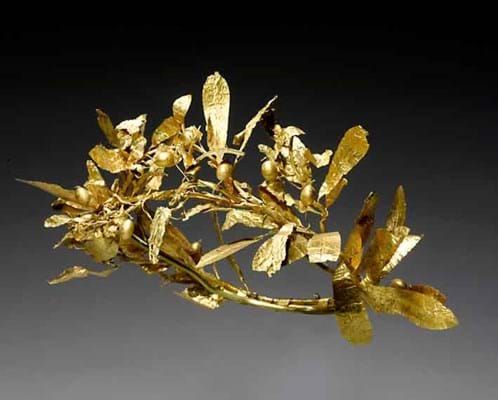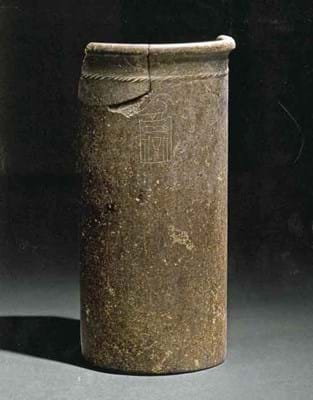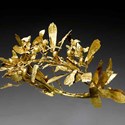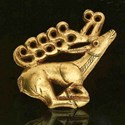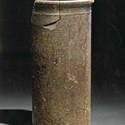Measuring 9½in (24cm), it took a five-times-estimate $275,000 (£185,810). It is similar to a wreath dated to the much later Hellenistic period, which took £150,000 at Christie's London in April.
Other jewellery lots included a pair of Etruscan earrings dating from the late 4th/early 3rd century BC which almost doubled the estimate at $150,000 (£101,351) and a late 3rd/early 4th century AD Roman gold armlet decorated with small rosettes and miniature theatre masks, which went at $190,000 (£128,378) - more than six times top hopes.
The buyer's premium was 25/20/12%.
A jewellery hit in Paris
The outstanding item in this month's 300-lot antiquities sale at Pierre Bergé & Associés was a 2in (5cm) wide, gold running-stag dress ornament from the Patti Birch collection.
Dated to the 7th-6th century BC, it is very similar in form to another excavated in 1897 and now in The Hermitage. The fleeing deer motif is characteristic of the Scythians and other peoples.
It sold at €500,000 (£416,665) at the auction on June 1.
Another great rarity in this wide-ranging sale was a very well-preserved ancient Egyptian pleated linen tunic dated to the 6th-11th Dynasties, which sold below estimate at €220,000 (£183,335).
The buyer's premium was 25/17.9%.
Egyptian vase sparks bidding war
The 265-lot sale of antiquities from two private collections held by Binoche et Giquello (26% buyer's premium) on May 30 produced a major surprise in the form of an early Dynastic Period cylinder vase inscribed in hieroglyphs with the name of King Narmer.
The 8in (20cm) high diorite vessel, dating from c.3150BC, was broken at the top and a large part of the rim was missing but it retained the all-important scratched inscription of a catfish over a chisel surmounted by a falcon, which spelled out the name of the first Pharaoh of unified Egypt.
Anyone hoping to buy it at the published estimate of €15,000-20,000 had to think again as bidding rose to €420,000 (£350,000).
Also going way over estimate was a 7in (18cm) high, Fourth Dynasty ointment jar of flared cylindrical form with a spreading foot.
Once again there were considerable losses but the scratched inscription was still fresh and clear. In this case the hieroglyphs included the name of Djedefre, a Pharaoh whose effigy in the form of a sphinx head excavated at Abu Rawash is one of the treasures of the Louvre. Bidding on this reached €280,000 (£233,335).

